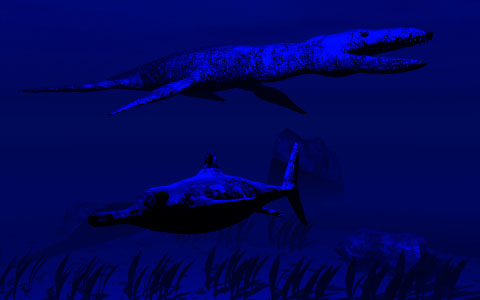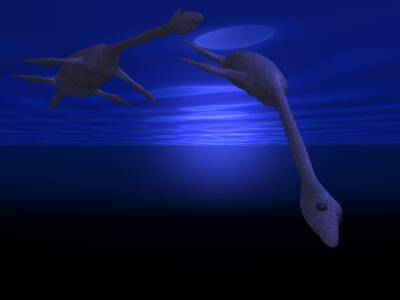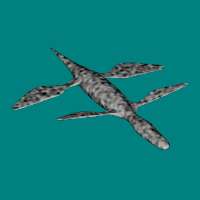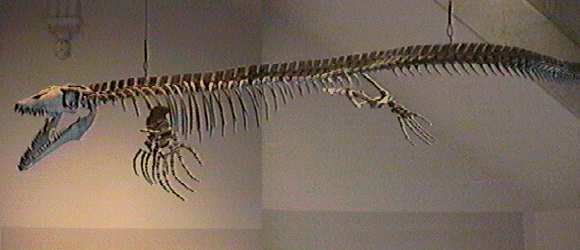pop up description layer
HOME
Cryptozoology UFO Mysteries Aviation Space & Time Dinosaurs Geology Archaeology Exploration 7 Wonders Surprising Science Troubled History Library Laboratory Attic Theater Store Index/Site Map Cyclorama

Custom Search
|
|
Reptiles of the Ancient Seas
An Ichthyosaur
(bottom) makes a lucky escape from the jaws of an eighty-foot-long
Liopleurodon. Perhaps sea serpents don't exist today, but they certainly did in prehistoric times. While dinosaurs ruled the land, their relatives, the great sea reptiles, ruled the ocean. In 1811 the fossilized skeleton of a monster was found embedded in a rock. Scientists were confused by what they saw: the shape of the creature was that of a fish, having a large dorsal fin on the back and flippers. Other features, including a long, pointed jaw filled with teeth, seemed more like a reptile. In the end they decided this strange creature which they named an Ichthyosaur (meaning "fish-reptile") was definitely a reptile despite its shape. The ichthyosaurs were a collection of related species with the same body-shape. One type, Shonisaurus, was almost 50 feet in length. Most of the ichthyosaurs were quite a bit smaller, though, and scientists theorize they may have behaved much like the porpoises of today. Both porpoises (which are mammals) and Ichthyosaurs have a teardrop-shaped torso body, a long snout, short fins up front for steering and a large crescent-shaped tail fin to drive them forward at speeds of up to 30 mph (50kph). Other great swimming reptiles from the days of the dinosaurs were soon found. The plesiosaur was an animal very unfish-like in shape. It had a rounded body with a long tail, long neck and four diamond-shaped flippers to drive it through the water. The tiny head sported a set of razor-sharp teeth.
Like the ichthyosaurs, plesiosaurs were really a class of animals with this same basic design. Within this line developed a wide variety of reptiles. One of these was the elasmosaurus which grew to a length of 45 feet. Elasmosaurus had an extremely long neck that allowed it to suddenly reach out and snap at a prey some twenty feet away. Another plesiosaur was the Trinacomerium. Trinacomerium was shorter than other plesiosaurs , with less neck, a bigger head and larger flippers that allowed it to race through the water in pursuit of its lunch. Out of the plesiosaurs came what is perhaps the greatest carnivore of all time: Liopleurodon. Liopleurodon was part of a group of short-necked plesiosaurs that became the pliosaurs. It is difficult to appreciate just how big liopleurodons grew. Some ran as long as eighty-feet in length and weighed as much as 100 tons. That's twenty times the weight of Tyrannosaurus Rex. The head of the biggest liopleurodon's were thirteen feet long with ten foot jaws. They sported teeth twice the size of a T-rex. What did a liopleurodon eat? Anything it wanted. In the prehistoric sea it was the king of the food chain. Plesiosaurs sailed through the water using four nearly-equal-sized flippers. No animal alive today uses this form of locomotion. For a long time scientists were puzzled as to exactly how these worked. Early theories suggested that the animals might have used their flippers like oars to "row" themselves along. This seemed awkward, though, so in the 1970's paleontologist Jane Robinson decided to take a close look at just how the muscles must have been attached to the plesiosaur's flippers. She reached the conclusion that the flippers must have worked like a set of wings and plesiosaurs literally flew though the water by flapping their flippers up and down.
Further studies suggested that the plesiosaurs had very strong muscles for the downstroke, but relatively weak ones for the upstroke. This has led some scientists to speculate that the animal would cruise through the water by pushing one set of flippers down to go forward, while the other set moved back up to get in position for the next power stroke. They may have even beat both sets downward together to get a sudden, short burst of power. All these sea reptiles shared one characteristic. They all had lungs, not gills, like fish. That meant they had to come up to the surface for air. This is another way they are similar to seagoing mammals of today. Toward the end of the reign of dinosaurs what may have been the most ferocious of these sea reptiles arose: the mosasaurs. These creatures lived after the ichthyosaurs died out and some scientists think they may have taken their niche in the ancient sea's food chain. Mosasaurs, who swam through the shallow sea that once covered the western United States, had long, tubular bodies. The tail was often a large fin and the nose a long, pointed narrow set of jaws with many teeth. Four flippers gave the creature stability and increased its speed. The largest of these animals, Tylosaurus, was fifty feet in length with a five-foot skull. Almost all of the great sea going reptiles died at the end of the Cretaceous era at the same time the dinosaurs went extinct. One sea reptile that has survived until today is the crocodile. Though a bit smaller than the fifty footers that lived in prehistoric times, the modern "croc" is basically unchanged in design. Is it possible that any of these creatures have survived into recent times to furnish us with tales of sea serpents or lake monsters? Some of the reports from Loch Ness sound like a plesiosaur. Some of the stories sailors tell seem to describe a monasaur. Although it seems unlikely, perhaps some fisherman in the-not-too distant future will pull in a net to find himself faced with a live ichthyosaur. Until that happens, if it ever does, we will have to be satisfied with seeing these magnificent sea reptiles in pictures. The bones of a Mosasaur.
Copyright Lee Krystek 1996-2000. All Rights Reserved. |
|
Related Links |
|
|






